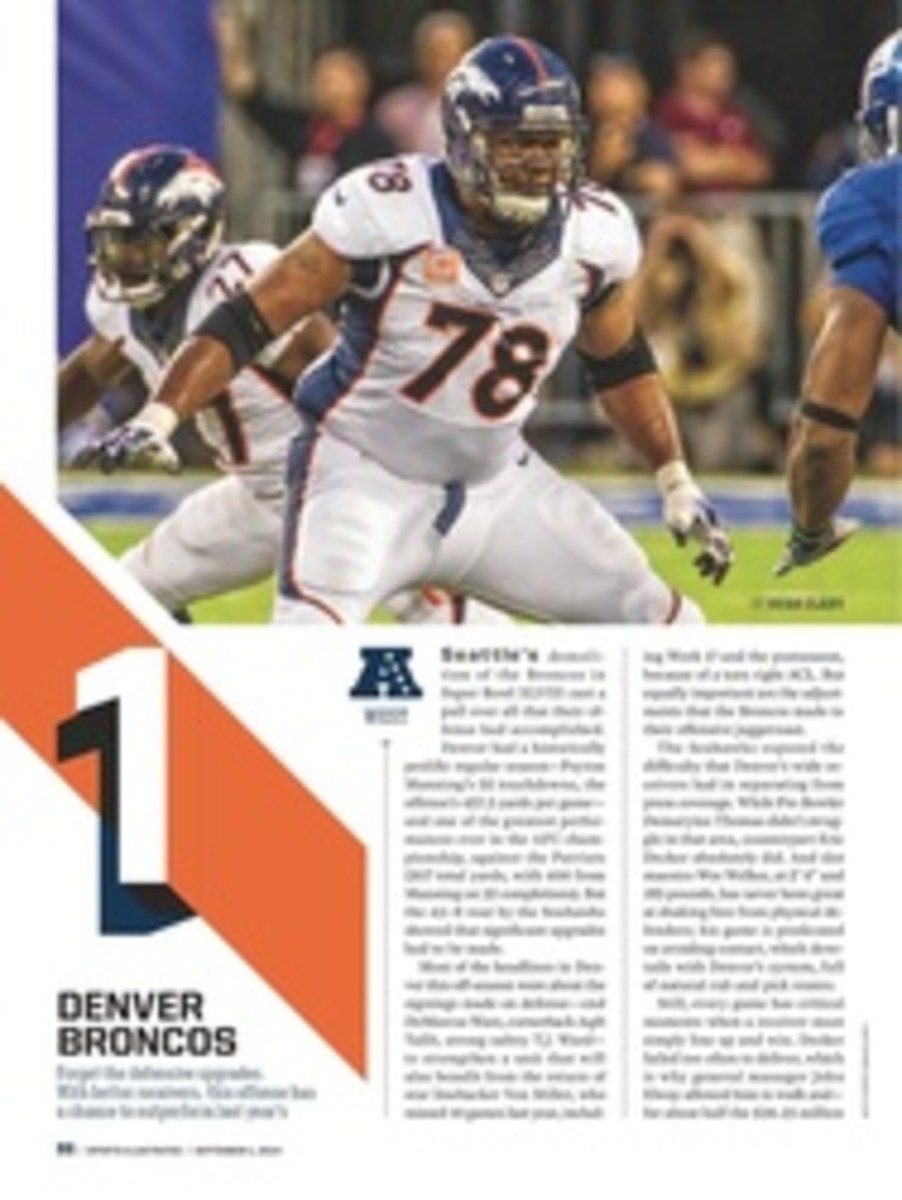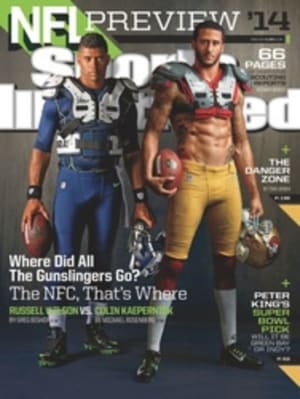
3 KANSAS CITY CHIEFS
To define a player's value, simply ask: How much does he factor into his team's wins? By this measure the most valuable nonquarterback in today's NFL could very well be Chiefs running back Jamaal Charles.
Kansas City went 11--5 last season despite having a defense that faded in the second half of the year and an offense that, in terms of raw talent, ranked in the bottom quarter of the league. On offense the same uninspiring group returns this year—only with less experience up front after the free-agency departures of left tackle Branden Albert and guards Jon Asamoah and Geoff Schwartz.
Still, the Chiefs made the 2013 playoffs, thanks to Charles and to coach Andy Reid's ability to manufacture offense. "Manufacture" is a short way of saying that Reid gets production out of players who cannot conjure it on their own. They're at the mercy of the play design, and fortunately for them, they're working for a cagey architect.
Reid depends heavily on leveraging Charles—the league's touchdown leader (19) in 2013 and the one Chief who can create his own opportunities. This shows up best in the screen game, with Charles coming out of the backfield. K.C. has also had success with screens to wide receivers and tight ends, often because defenses are keying on Charles. The common element in all the screens is misdirection. The plays begin with an aggressive flow one way before winding back to the other side, where space has been created. Reid loves this tactic, especially in the red zone, where room is tight.
His other methods of manufactured offense include play-action passing (especially on early-down deep shots), rolled pockets (which can also involve misdirection) and other plays with sharply defined either/or reads for the quarterback. Reid will continue to operate this way with the meager-armed Alex Smith, whose field-reading abilities do not quite correlate with his off-field intelligence. As a decision-maker, Smith (now in his second year with the Chiefs after seven bumpy seasons in San Francisco) is slow and resoundingly cautious. Rarely does he pull the trigger on downfield or even intermediate-length throws, and he's not asked to execute many multiprogression dropback reads.
Not that Smith would have great-looking reads available anyway, because his receivers all have limitations. For Dwayne Bowe the issue is speed. For Donnie Avery it's strength and sure-handedness. For A.J. Jenkins it's experience—which, given that he was the 49ers' first-round pick in 2012 before being traded to the Chiefs last year, means he's also shown other limitations in practice. By not signing a free agent of note or selecting from a deep pool of rookie receivers in the draft, Reid and GM John Dorsey are leaning heavily on the coach's ability to create schemes that will get guys open—or, given Smith's limitations, wide open.
One potential weapon, at least, is tight end Travis Kelce, a 2013 third-round pick out of Cincinnati who is coming off knee surgery that wiped out virtually his entire rookie season. While veteran Anthony Fasano is the short-receiving option, the 6'5", 260-pound Kelce will be asked to provide an interior vertical element in the passing game out of two-tight-end sets. If Kelce can effectively move around the formation (including off presnap motion), Reid will have more ways to create misdirection.
Included in those misdirection designs will be speedy De'Anthony Thomas (4.50 in the 40), a fourth-round choice out of Oregon, who will fill Dexter McCluster's old gadget role. McCluster, who signed with the Titans, was more of a receiver who could also play running back. Thomas is more of a running back who can also play receiver. To get Thomas meaningful reps, the Chiefs may have to keep last year's talented third-round pick Knile Davis on the bench more than they'd like. At least they have the resources to allow Charles, 27, to take more breathers.
While Kansas City's defense has more talent, this blitz-heavy unit also depends a great deal on designs for its success. But what happens when opponents figure out those designs? In the first half of last season the defense allowed the fourth-fewest yards in the NFL. In the second half it allowed the most. That's the scary part about relying on schemes: The puzzles can be solved. Which is why exceptional talents like Charles are so valuable.
2014 SCHEDULE
2013 Record: 11--5
WEEK 1
TEN [HOME]
DEN [AWAY]
MIA [AWAY]
NE MON [HOME]
SF [AWAY]
BYE
SD [AWAY]
STL [HOME]
NYJ [HOME]
BUF [AWAY]
SEA [HOME]
OAK THUR
DEN [HOME]
ARI [AWAY]
OAK [HOME]
PIT [AWAY]
SD [HOME]
WEEK 17
MAJOR CONCERN
Pass defense
Kansas City's defense collapsed in the second half last year as offenses began to figure out its blitzes. In fairness, those designs also became less potent with star edge rusher Justin Houston battling injuries. But as the pressure lessened, quarterbacks had more time to throw and the Chiefs' man-to-man coverage cracked. Not only were more passes being completed against them, but they also missed more tackles. There's no promise that things will get better for the K.C. secondary in 2014. Top corner Brandon Flowers was released in a cost-cutting move, meaning that 2013 seventh-rounder Marcus Cooper will be starting opposite Sean Smith. Cooper ran hot and cold as a rookie. Like Smith, he has little experience playing inside, which limits K.C.'s flexibility in coverage. Filling the inside duties will be either mediocre veteran pickup Chris Owens or third-round rookie Phillip Gaines (Rice).
THE CASE FOR
Strong safety Eric Berry
Early in his career 2010 first-round pick Berry had a glaring weakness: man coverage. But after getting torched by tight ends in '12, Berry dedicated his off-season to improving that aspect of his game. In '13, not only did he take on tight ends in man-to-man, but he also often stifled them—including top players like Dallas's Jason Witten and Cleveland's Jordan Cameron. As good as the 6-foot, 211-pound Berry is now in coverage, he makes an even bigger difference as a linebacker, where he's heady against the run and dangerous on blitzes. Berry actually lined up at linebacker more often than at strong safety last year because of his role in coordinator Bob Sutton's dime package. By putting six defensive backs around rangy linebacker Derrick Johnson, Sutton's D had immense speed across the board, lending great unpredictability to Kansas City's blitzes. With athletic nosetackle Dontari Poe able to stay on the field in dime situations (which is remarkable for a 346-pounder), the Chiefs had an interior force who could create blitz angles. This helped propel them to the playoffs. It couldn't have happened without Berry.
PHOTO
AL TIELEMANS/SPORTS ILLUSTRATED
RB JAMAAL CHARLES
PHOTO
JAY BIGGERSTAFF/TUSP/AP
NINTEEN PHOTOS

